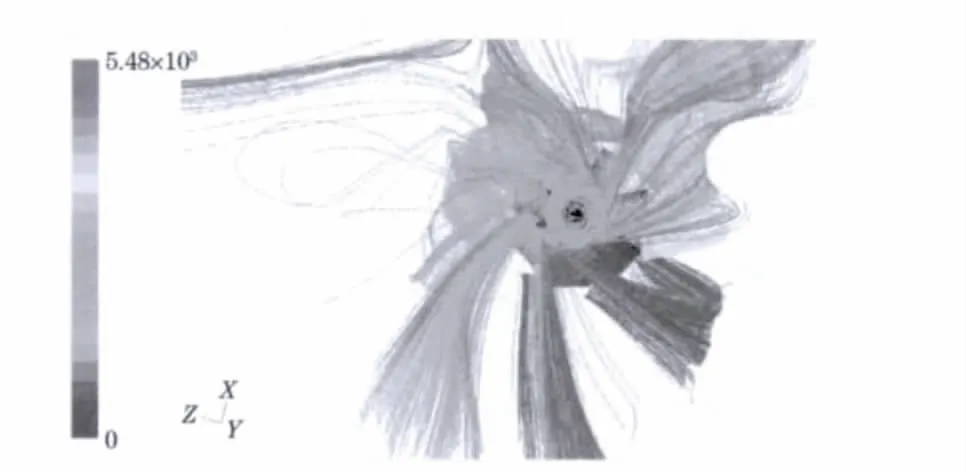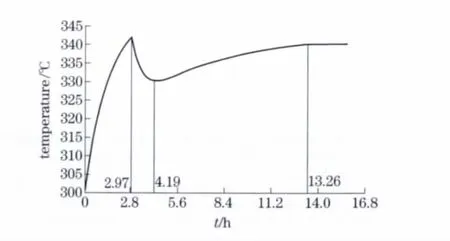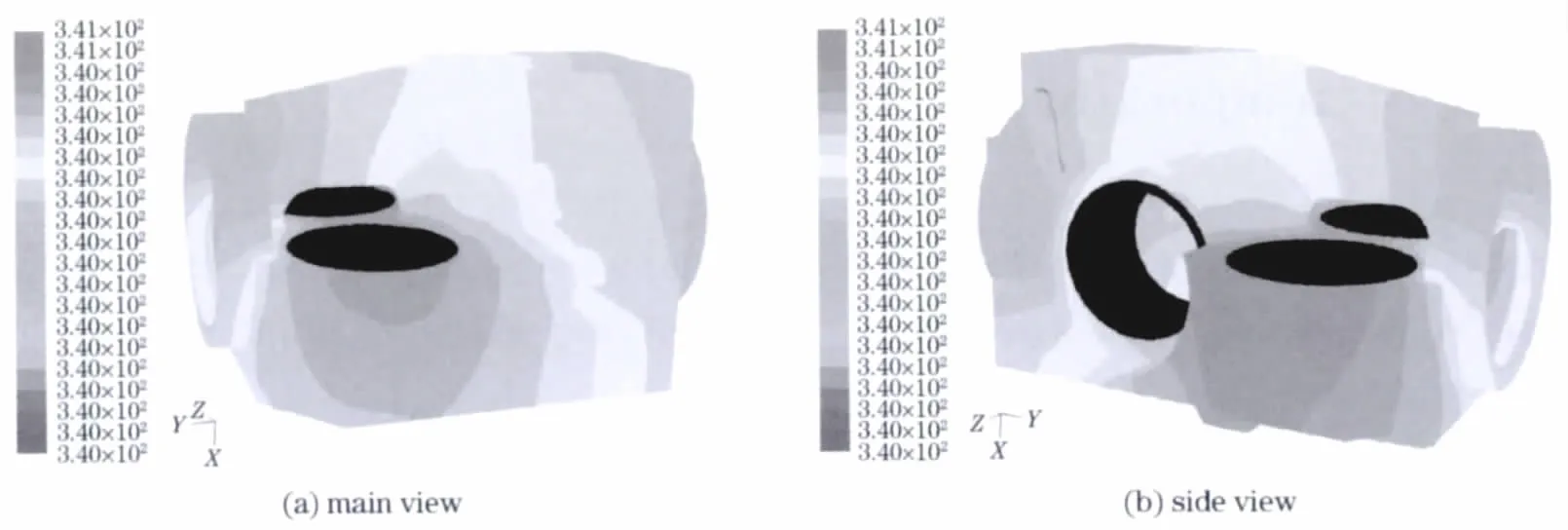Temperature field simulation technology for thermostat electromechanical systems
WANG Ya-bin(王亚斌), YUAN Shuai(袁帅)
(National Key Library on Electromechanical Dynamic Control,School of Mechatronic Engineering,Beijing Institute of Technology,Beijing 100081,China)
Inertial navigation system is used to control the position-orientation and trajectory of the moving objects,such as aircraft,submarines,spacecraft and guided missiles,etc.,by measuring their angular velocityor angular displacement with respect to the inertial space.It's an important navigational tool,which is widely used in today's space and defense industry.
Inertial nagivation system is an instrument of precision and very sensitive to changes in temperature[1].The uneven temperature distribution in the platform will significantly affect the accuracy and stability of the system performance while working.As a result,a further research on temperature distribution of the inertial navigation system is of great significance[2].
1 Temperature field simulation of electromechanical systems
1.1 Construct the model for simulation computation of system's temperature field
The platform system's 3D model in standard format for the exchange of product model data(stp)is highly complicated in surface morphology,so it's very difficult to generate CFD meshes and solve on the basis of stp model,and it is necessary to perform geometric cleaning and editing to the platform system.HyperMesh,a powerful preprocessing software in the field of CAE,has a strong Automesh module that can realize efficient mesh generation for a large number of 2D units,and can also meet the urgent need of this research project to fair the platform system's surface meshes[3].Considering the factors above,the researchers select HyperMesh software as the preprocessing platform for research of this project;Fig.1 and Fig.2 show the model before and after processing.

Fig.2 Simplified model of system
The CFD mesh function and tetra core mesh generation method are used to set the number of boundary layers,initial boundary layer thickness,growth rate,mesh generation strategy&optimization plan and other parameters of the surface mesh already constructed,and perform body mesh generation of the system's body mesh model[4].Fig.3 shows the completed model for numerical simulation analysis of the platform system.
1.2 Simulation computation of temperature field of system temperature control device
The boundary conditions need to be set separately in FLUENT.The items are set include the values of flow variable,heat variable,their components and other variables on the boundary,setting of boundary conditions is a key step of FLUENT analysis,so setting of each item must be performed cautiously.
The boundary conditions involved in the simulation of this platform system are mainly classified into three types:
①Wall surface boundary condition:coupled wall and separate wall.
②Internal unit area:liquid and solid.
③ Internal boundary:fan,wall surface and internal interface boundary conditions.
Setting of wall surface boundary conditions mainly involves the independent walls outside the cabinet and coupled walls between adjacent internal entities.Selectting the coupled function in the interface for setting the coupled walls,the energy transfer between different entities can be completed automatically through the common boundaries;the convection function in the interface is selected for setting the independent wall outside the cabinet,and the convection coefficient for the space outside the cabinet is set at 5.04 W/(m2·K).
Setting of solid boundary conditions is mainly classified into setting for heat sources and nonheat sources[5],setting for non-heat sources involves only the selection of suitable material parameters,while setting of a heat source's boundary conditions involves defining source-terms to define other terms.Setting of the fan's boundary conditions is completed though the function of dynamic mesh.It mainly includes the determination of the fan axis'coordinates and rotation direction,and the corresponding revolving wall.We research and summarize the temperature field distribution rule of the platform system in two operating modes corresponding to the working state un-der specific conditions[6].

Fig.3 Schematic diagram of CFD mesh panel
2 Analysis of temperature field results
2.1 Platform system's temperature field distribution in the stable state—operation mode one
The conditions are :power supply voltage:50 V;heating plates:working;other heat sources:not working;fans:working;temperature outside the cabinet:25.00℃;the full power of heating plates is p=54 W,each heating plate's power is 18 W,total heating power is 54 W,number of fans is four.The simulation computation will obtain the time needed for platform body temperature to reach 69.00℃,and will also give the temperature distribution of the platform body,ring stand and air shed.Results of simulation are shown in Fig.4,Fig.5,Tab.1.

Fig.4 Schematic diagram of pathlines around the fans

Fig.5 Plan of flow field distribution around the platform body

Tab.1 Extreme value of platform body temperature
After 2.97 h work,the highest value of the platform body temperature reaches 69.00℃,then the heating plates are shut,and otherheat sources start to work,the temperature of the environment outside thecabinetisstabilized at 25.00℃.In this stage,the extreme value of the platform body temperature starts to fall gradually,after 4.19 h,it falls to the lowest point,then the platform body temperature extreme value is again on the rise,as shown in Fig.6.

Fig.6 Chart of the temperature's overall variation tendency
Under the condition of no change to each operation mode,computation is continued until the platform body temperature doesn't change any more.At that point the platform body's highest temperature is 66.41℃,the lowest platform body temperature is 65.84℃,and the temperature difference is 0.57℃.This process is as long as 13.26 h.The platform body temperature distribution at such point is shown in Tab.2.

Tab.2 Extreme value of platform body temperature
2.2 Platform system's temperature field distribution in the stable state—operation mode two
The conditions are :power supply voltage:50 V;heatingplate:not working;other heat sources:not working;fans:working;temperature outside the cabinet:stabilized at 25.00℃;number of fans:four.The platform body temperature distribution at such point is given.About 12.57 h later,the temperature enters the stable state.At such point,the highest temperature value of the platform body is 66.40℃,the lowest temperature value is 65.83℃,and the temperature difference is 0.57℃.Results of simulation are shown in Fig.7 and Tab.3.

Fig.7 Plan of platform body temperature distribution

Tab.3 Extreme value of platform body temperature
After summarizing the analysis result above,it is found that the difference between temperature values of the platform body in the stable state is 0.01℃,the ranges of the platform body's highest and lowest temperatures are both 0.57℃,which shows that when the boundary conditions are the same,the platform system's temperature field distribution is basically the same,according to the design requirements,the system's ideal working environment is 59.00℃ -69.00℃.After comparing the analysis results under the two conditions above and the ideal indexes,it is found that the platform system's temperature field performance indexes can meet the requirement for normal work.
3Summary
In order to improve the precision of numerical simulation result,the project adopts mainly the following methods:
①The technology of secondary generation of meshes is adopted to optimize the finite element model's quality,realize high-precision modeling and achieve improvement of both precision and efficiency.
②According to the energy residual curve fed back from the system and the energy diffusion ratio,manual adjustment can be used to realize local optimization.Then the degree of confidence of the highly complicated nonlinear model's result is guaranteed.
In addition to the improvement of the simulation precision,the result of the research explored in this paper reveals the temperature field distributionlaw in a quantitative way,obtains the influence from the comprehensive action of heat transfer and heat convection on the distribution of the platform system's temperature field[7],and provides the reference frame for further optimization of the platform system design and computation of multi-field coupling.
[1] Wang Yabin, Yuan Shuai. Research ofthermal stress analysis on fuze[J].Applied Mechanics and Materials,2011(68):114-118.
[2] Loukianov D P.Laser and fiber optic gyros:the status and tendencies of development[J].Information of Inertial Technology Abroad,2004(1):17-35.
[3] Wang Yabin,Liu Mingjie,Tan Huimin.Numerical calculation of artillery-fuze system dynamic characteristics[J].Journal of Beijing Insittute of Technology,2007,16(4):384 -387.
[4] Wang Yabin,Liu Mingjie,Tan Huimin.Mechanism modeling and simulation based on dimensional deviation[J].Journal of Beijing Insitute of Technology,2008,17(4):419 -422.
[5] Tao Wenquan.Heat transfer[M].Shaanxi:North-Western Polytechnical University Press,2006:17 -18.(in Chinese)
[6] Liu Gaotian.Numerical simulation of temperature field[M].Chongqing:Chongqing University Press,2000:41-67.(in Chinese)
[7] Ding Yanwei,Fu Junming,You Zheng.Satellite thermal control system design and simulation[J].Journal of System Simulation,2006,18(1):169 -172.(in Chinese)
 Journal of Beijing Institute of Technology2013年2期
Journal of Beijing Institute of Technology2013年2期
- Journal of Beijing Institute of Technology的其它文章
- Weight distribution of sub-munitions fuze design
- Analysis of vehicle powertrain dynamic performance
- Roundness error evaluation by minimum zone circle via microscope inspection
- Strategy to control crawling vehicles with automated mechanical transmission
- Control strategy for hybrid tracked vehicles using fuzzy logic
- Experimental study on durability fracture behavior and vibration modal sweep for vehicle rear axle
